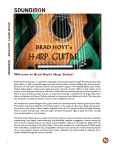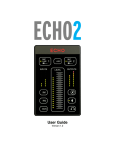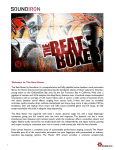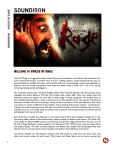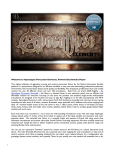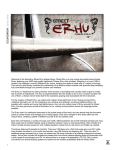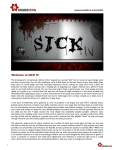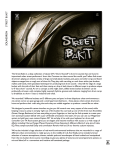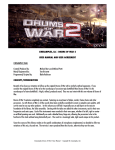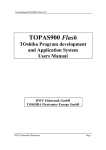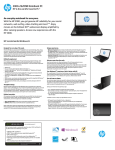Download PDF user manual - s3.amazonaws.com
Transcript
ACOUSTIC SAZ VER SOUNDIRON 1.0 Acoustic Saz is a truly, deeply sampled 5-string acoustic saz baglama library for Kontakt with a huge range of extended content, an innovative new custom interface and cutting-edge powerful performance features. This beautiful fretless Saz was procured directly from the streets of Turkey, where master craftsman have been building them by hand for centuries. We painstakingly sampled all three “runs” of strings (low octave, middle single and high unison) with a massive 12x round robin and up to 6 velocity layers for open notes on an octave and a half per string. Continuing the depth are palm mutes, string chokes, release samples and a slew of percussive effects all at 12x round robin with multiple velocity layers. The Saz is a very expressive instrument and therefore requires more than just open notes and palm mutes to get truly expressive and natural performances. As such, we carefully sampled a wide legato, or “slide” range for all three runs of strings with multiple velocity layers and 4x round robin. Our exciting new interface offers unique control over how a note is played and which string it is played on, allowing you to flip between features instantly at the push of a button. Hammer-on, pull-off, slide, choke and palm mute are all controlled on a per string (or all strings) basis, which can be momentary (as long as a key is held) or latching (turned on and off with subsequent presses of the key). We’ve also included an intelligent auto-strumming system called the “Strumulator”, giving you instant access to 12 different chords which automatically ensures that each note is played on the appropriate string. There are special patches for creating custom tunedpercussion blends, effects, Uberpeggiator and of course ambiences. Brand new to the Acoustic Saz is our powerful Effects Rack system. This new system gives you an elegant and intuitive interface with access to a wide range of effects including Chorus, Flanger, Phaser, Dynamics, Drive (featuring 4 different effects), 2 amp sims, 8 cabs, EQ, Filter, tempo-synched Delay and convolution Reverb with a bunch of new custom impulses. We set out to make the Acoustic Saz the most realistic, playable and flexible instrument we could, expertly capturing it’s naturally beautiful sound in stunning clarity and unmatched depth. Combined with our powerful custom interface, we put the life and feel of the actual instrument into your hands. Enjoy! 1 ACOUSTIC SAZ SOUNDIRON SOUNDIRON Acoustic Saz version 1.0 OVERVIEW 24 open format Kontakt .nki instrument presets (13 Kontakt 5/11 Kontakt 4) Deep-sampled Acoustic Saz with 12x RR on notes and 4x RR on Slides New Powerful FX Rack to Apply and Combine Effects 6,971 Samples 6.8 GB Installed 24bit / 48kHz stereo PCM wav samples (non-encrypted) Powerful custom performance and FX control interface 45 custom environmental and digital reverbs and 25 special FX impulses integrated into the GUI Note: • The full version of Kontakt 4.2.4 (for K4 presets) and Kontakt 5.1.0 (for K5 presets) or later is required. • The free Kontakt “Player” and special “Libraries” tab do not support this library. CREDITS Recording, Editing, Programming, Photography and Sound Design by Gregg Stephens Beta Team Brad Halverson, Chris Cutting, Dmitry Selipanov, Arkadiusz Reikowski, Ryan Scully, Marie-Anne Fischer, Xioatian Shi, Max Zhdanov, Paul Amos, Simon Russell, Andy Gray and Sascha Knorr Scripting & Systems Design by Chris Marshall and Gregg Stephens UI Design & Artwork by Gregg Stephens, Constructive Stumblings and Chris Marshall Special Thanks Peter Simms and Katie Simms, Obsidian Dawn TABLE OF CONTENTS General :: INTRODUCTION - Page 1 OVERVIEW & CREDITS - Page 2 Technical :: FIDELITY, ACOUSTICS, FORMAT & CONVOLUTION - page 3 SYSTEM REQUIREMENTS, DOWNLOAD & INSTALLATION - Page 4 User Interface :: MAIN FRONT PANEL & EQ CONTROLS - Page 5 PERFORMANCE PRESET CONTROLS - Page 6-9 PERFORMANCE (SIMPLE) PRESET CONTROLS - Page 10 UBERPEGGIATOR CONTROLS - Page 11 TUNED PERCUSSION CONTROLS - Page 12 GLISSATRON CONTROLS - Page 13 FX RACK CONTROLS - Page 14-16 Instrument Descriptions :: PRESET TYPES - Page 17 Info :: LICENSE AGREEMENT - Page 18 THANK YOU - Page 19 2 www.soundiron.com ACOUSTIC SAZ SOUNDIRON ABOUT THIS LIBRARY Fidelity This library was recorded in wide stereo at 48kHz / 24bit. Some content was recorded live and in natural environments, while other portions have been heavily manipulated with a variety of post production tools to create special effects. Therefore, please keep in mind that this library isn’t designed to provide perfectly sterile samples. Format Accessibility All of the sample content and impulse files are included as standard non-encrypted PCM wav files and standard openformat Kontakt presets to allow you easy access to manipulate, reprogram and customize the sounds however you prefer. We know that it’s important for many users to be able to go beyond the limitations of any one sampler or preset structure, so we’ve kept this library’s directories and files open for advanced users. As a professional, you may have your own workflow or format requirements, and we trust that you'll respect our hard work and won't share this content with anyone who hasn't paid for it. Keep in mind that to use and/or edit the Kontakt presets, you’ll need the full retail version of Native Instruments Kontakt 4.2.4 (K4) or Kontakt 5.0.3 (K5) or later. Please be aware that the free Kontakt “Player” and any other version or form of Kontakt that came bundled with any other library or software product (other than NI’s “Komplete” package) will not support this library. The free Kontakt Player is NOT a full version of Kontakt and cannot load or play standard open-format Kontakt instruments or libraries. Please read all instrument specs and software requirements before purchasing this or any other Soundiron products to see the full list of software requirements, features and format compatibility for each library. While you can reprogram the samples or presets to other formats, we always recommend using Kontakt for best results, since it widely considered the industry standard and easily the most powerful sample programming and playback platform on the market. However, if you wish to convert or reprogram the wav files and instrument presets into any other sampler or softsynth format, be aware that not all settings and properties will translate accurately, reliably or even at all from one instrument or audio format to the next, due to vast differences in standards, behaviors, structures and capabilities that each platform relies on. 3 Custom Convolution Impulses We enjoy capturing the unique acoustic characteristics of spaces and locations that we come across from time to time. Sampling environments is similar to sampling instruments in many ways. It’s done with portable loudspeakers to produce a special sine wave sweep that covers a wide spectrum, from 22 Hz to 22 kHz. We then use dedicated deconvolution software to decode the resulting audio into an impulse response file, which is a wav file with special phase, frequency and timing information embedded in the audio. Most impulses sound like an odd sort of sharp snap, like a balloon pop or starting pistol fired in the environment that was captured – which is is in fact how impulses used to be made. When loaded into a compatible convolution reverb effect (such as the one built into Kontakt), these impulses impart their sonic properties fairly well into most sounds. Of course, it's an imperfect science and much is lost in the translation, especially if the sound being played through it also has it's own strong tonal, phase or reflective properties. Sometimes the results are incredibly lifelike and just as often, they can be completely surreal. It all depends on the sound, the impulse, the settings you choose. We've included a hand-selected collection of impulse files that we think compliment this library’s sound directly built into the GUI. You can load them into most instrument presets by using the Reverb control panel and selecting an impulse from the Impulse drop-down menu. You can also manually import any of your own wavs into the Convolution effect within Kontakt’s instrument editor view, down in the Insert Effects module. Just make sure to set the Reverb control to On and Custom to enable convolution impulse wav import and custom preset saving. Be aware that convolution processing can often create powerful and piercing resonances when applied to many audio sources – especially loud sounds that contain strong mid to low frequency harmonic components. ACOUSTIC SAZ SOUNDIRON System Requirements Manual Download Please be aware that many instrument and multiinstrument programs in this library are extremely ram/ cpu and hard disk-streaming resource intensive. We highly recommend that you have a 64-bit operating system (Windows or OSX) with at least 4GB of system ram, a quad-core cpu and a 7200 rpm SATA hard disk or better before purchasing this particular Soundiron library. Large sample sets like those found in this library may load slowly and may cause system instability on older machines. If you have any trouble with our Downloader utility or prefer to use your browser or another download manager, log into your personal manual download page on our website, by using the direct link in your download email. Log in using your download code. Or, if you used the downloader originally, but you need to re-install the library manually for any reason at a later time you can always re-use the original rar files. To do that, you'll need Winrar, UnrarX or another full-featured Rar extraction utility to extract and install the library. Please note that Stuffit Expander and Winzip DON’T support many types of common rar files. Download & Installation We provide the Continuata Connect download manager to offer high-speed, reliable and fully automated library downloading and installation. Download and run the latest version for your OS (PC or Mac) before proceeding. You may also need to add special permissions to your security software for the downloader, if it blocks applications from accessing the web. Next, copy-paste your download code from your download email into the Code box in the downloader window. Make sure to leave out any spaces before or after the code. Press the download button and select the location you'd like to download and install the library. It will automatically start downloading the file(s) and then error-check, extract and install the finished library. Once installation is fully complete, you can remove the .rar download files and store them in a safe place as a back-up copy. We always recommend downloading the latest version of our downloader before you begin. The link in your email will always take you to the latest version. Preset Loading Once installation is complete, you can browse and load the included .nki presets using the Files or Database tabs in the Kontakt Browser, or through the main File load/ save menu. Please allow presets to finish loading completely before loading a new one. You can’t use the Libraries view to load standard open-format Kontakt Instruments like this library. Only locked “Powered-ByKontakt” Libraries are visible to that propriety browser view. The “Add-Library” function does not support this product or any other open-format Kontakt library. This library doesn’t require any special activation. Don't move, rename, delete or modify any of the files or folders created during the download until after you see the status message for all files in your download queue display the word "INSTALLED". Please don't close the downloader while it's actively downloading, unless you press the pause button first. To resume downloading, press the Resume button. If you need to resume downloading after closing the downloader, run it again and enter your code and press Download again. Then select the same download/installation location on your computer that you chose originally. If the downloader reports a DL Error or Install error, it will automatically try to download the file again until it successfully downloads and verifies all the data it needs. It’s best to allow it to finish the process before trying to move or access the library data. Please see your download email for more detailed instructions. 4 ACOUSTIC SAZ SOUNDIRON Common Front Panel Controls This instrument has a variety of special front panel performance controls that allow deep real-time performance customization. While Acoustic Saz contains multiple preset categories that share a number of common controls which allow users to shape the sound.You can see each control’s internal midi CC assignment by hovering your mouse over many of the controls and looking down at the “hint” text displayed in the Info bar at the bottom of Kontakt. To turn on the Info bar, press the “i” button at the top of Kontakt. To assign midi CC automation to any knob, simply right-click (PC) or Command-Click (Mac) on the knob and then click the Assign Midi CC button that appears. The next midi controller you move will automatically be assigned to the control.You can access more automation features in the “Auto” tab window on the left side of Kontakt. You can customize and create your own custom presets by using the File Save/Load menu at the top of Kontakt. Just choose a new preset name and save it in the same Instrument folder location to insure that Kontakt can locate all necessary files the next time you load it. All custom control knob settings will be saved with the instrument preset. Swell - (CC 72) This knob controls the volume swell of the instrument. Attack - (CC 74) This knob controls the sharpness of attack. Lower values have more of a pluck sound. Release - (CC76) This controls the release time of the main note samples.* Lower settings cause the sound to be damped and cut off, while higher settings allow notes to ring out longer. Start Offset - (CC78) This controls the amount of sample start offset allowing you to jump ahead into samples to change the sound. This can also be used to control the amount of “pluck.” Release Volume - (CC90) This controls the volume of release samples only. These samples play when the last note of a string is released. The small glowing radio button toggles Release Samples on/off if you don’t want them to play at all. EQ Controls EQ3 On/Off This red LED button next to the “EQ” enables/disables the 3-band Parametric EQ. Treble Slider This slider sets the amount of gain for the treble frequency band. Bass Slider This slider sets the amount of gain for the bass frequency band. Mid Freq. Knob This knob at the bottom of the EQ sets the frequency for the mid band, making the middle frequency completely sweepable. Mid Slider This slider sets the amount of gain for the mid frequency band. *Release knob controls release time of Palm Mute and Choke samples in the main Performance patches. Release of main note samples is fixed in these patches due to the Slide legato system. 5 ACOUSTIC SAZ SOUNDIRON Preset Types Acoustic Saz contains three main preset types: Performance, Performance (Simple) and Tuned Percussion. Each preset type offers its own strengths and each was designed to be useful for different composition styles. Also included are “Lite” versions of each preset type which are presets that are less CPU- and memory-intensive at the cost of realism by reducing the number of round robin variation. ** Please Note - The main presets require Kontakt 5.1.0 or higher. Inside of the “K4” subdirectory are Kontakt 4.2.4 compatible presets. These presets are not recommended for performance reasons and they lack a number of Kontakt 5-only features but have been included as legacy support. Performance The Performance preset attempts to simulate the real-world function of an Acoustic Saz. Each of the 3 strings of the Saz is represented as its own monophonic unit with individual modes for slides, hammer-on/ pull-offs, palm-mutes and chokes. String ranges are set via the UI but can be overridden. All important functionality is also controllable via keyswitch. The Performance preset is the most feature-heavy (and therefore CPU-intensive) preset in the library.This type includes full Round Robin, slides, hammer-on/pull-offs, palm mutes, chokes and the powerful Strumulator. Swell - (CC 72) This knob controls the volume swell of the instrument. Attack - (CC 74) This knob controls the sharpness of attack. Lower values have more of a pluck sound. Release - (CC76) This controls the release time of the palm mute and choke samples. Lower settings cause the sound to be damped and cut off, while higher settings allow notes to ring out longer. Start Offset - (CC78) This controls the amount of sample start offset allowing you to jump ahead into samples to change the sound. This can also be used to control the amount of “pluck.” 6 Release Volume - (CC90) This controls the volume of release samples only. These samples play when the last note of a string is released. The small glowing radio button toggles Release Samples on/off if you don’t want them to play at all. EQ The Performance preset type features a full 3-band parametric EQ with a sweepable mid frequency. See Page 5 for more details. Range Controls In the top left of the UI are a set of three knobs and 3 value edits. Each knob-value edit pair control the range of one of the three Saz strings; the knob is present to allow midi CC automation. See Page 7 for details. Play Mode Controls In the top right of the UI on the fret board are a series of buttons which control the playback mode of each (or all) strings. See Page 7 for details. Panel Controls Nestled in the bottom left of the UI are buttons which, when pressed, open a tab with a variety of controls and information. See Page ? for details. ACOUSTIC SAZ SOUNDIRON Performance continued The Performance preset is a complicated instrument that can seem daunting but it is also the most powerful preset available. This section looks at some of the more advanced functionality. Strings and String Ranges As mentioned previously, each individual Saz string is conceptualized as an independent monophonic unit separate from the other strings. This logic mirrors that of the real-world instrument: one can play each string in a different way, perhaps sliding on the low string, palm muting the middle and hammering-on the high string. The natural range for each string is as follows: Low : F2 - C4 Mid : C3 - G4 High : A3 - F5 String Controls From top-to-bottom, the knob-value edit pairs pictured to the left represent the low, mid and high strings of the Saz. These controls can be used to set the range of each string. The highest available note of one string depends on the low note of the string that is higher to prevent any gaps where no string would be mapped. Each string’s range is represented on Kontakt’s built-in keyboard (shown below) by the blue (low), red (mid) and green (high) key ranges. The string ranges can be overridden on-the-fly using the “Allow” keyswitches and UI controls. Play Modes Each string has a variety of toggleable play modes. These can be controlled using keyswitches or via the user interface controls pictured to the left. Each radio button represents a string just like the range controls, low, mid and high from top-to-bottom. The label (like Slide or H.On) can be pressed to toggle the mode on/off for all strings. Please be aware that certain modes override other modes where it makes sense logically, like Palm Mutes and Chokes overwriting one another. Choke P.Mute Allow H.On Slide The modes controls live on the neck of the Saz in the top right of the UI. Slide This play mode plays slide samples between notes. Keep the previous note held down momentarily after pushing the new note. Slides can also be controlled using the red keyswitches as shown to the left. H.On (Hammer-on/Pull-off) This mode simulates hammer-ons and pull-offs. Within the confines of each string, any new note press after the first functions as a hammer-on, and if on note release a lower note is still held, that note will be played simulating a pull-off. This mode can be controlled using the green keyswitches. Allow This special functionality is used to override the string ranges that are defined by the user. When active for a string, that string takes precedence over other strings in any natural overlapping ranges. This lets users play notes on strings all the way up the neck. If “Allow” is active for more than one string, both strings will sound on notes where they overlap. This can also be controlled using the blue keyswtiches. ^^^ ^ 1 2 3 All P.Mute (Palm Mute) These switch the string to play palm mutes instead of normal. open notes These can also be controlled using the yellow keyswitches. Choke This mode chokes the string to produce a non-pitched, more percussive sound. This mode can be controlled using the cyan keyswitches. 7 ACOUSTIC SAZ Performance continued Effects Panel Controls In the bottom left of the UI are buttons which, when pressed, open a tab that contain more controls and extra information. Each panel is described below and on successive pages. Settings - This panel contains keyswitch and legato settings. SOUNDIRON Strumulator - This panel contains strumulator settings and controls. Quick Help - This panel displays quick help info about keyswitches and ranges. Settings Panel The settings panel contains various options for keyswitches and legato (slide). Keyswitches Each of the 5 keyswitches can be either momentary or latching. Momentary keyswitches reset after the keyswitch key is released. Latching keyswitches toggle state on each key press. Range This controls the range within which successive notes (within a string’s range) will legato and play slide samples. Speed (CC95) This controls the speed of legato (slide) transitions. In the special TMPro preset type, the slide samples are in Time Machine Pro mode so the actual sample is sped up or down depending on the speed setting. Int. Vol. (CC96) This knob controls the volume of the slide samples. Quick Help Panel This quick help panel is available to provide a fast way to access the most important information regarding functionality. The information displayed shows where and what the keyswitches are and what the string ranges are. 8 Strumulator Panel SOUNDIRON ACOUSTIC SAZ Performance continued Strumulator Controls The Strumulator is a mode that automatically plays a chord based on the root note pressed. To conform to the functionality of the real-world Saz instrument, Strumulator chords played on the lowest string will play 3 notes, chords on the middle string will play the first two notes in a chord and the high string will ignore any chord. All chords are based on standard Saz fingerings. Velocity Table This table can be used to customize the velocity of each note in a chord when the velocity button is active. When one of the steps is set to zero, the note will be skipped. Velocity Button When on, the Strumulator uses the table for velocities instead of played velocity Tightness This knob sets the amount of time between notes in a chord. Lower values are tight strums, while higher values are more of an arpeggiation. Reset Button This button clears the velocity table. Random This knob adds an amount of randomness to each delay between each note in a chord. This humanizes strums and makes them sloppy. Save Button This button (in K5 presets only) can be used to save the current table levels to a preset. Load Button This button can be used to load a table preset. 9 Chord This knob selects the chord type to be played by the Strumulator. When “Off” the Strumulator is bypassed. The active chord can also be controlled using the black (inverted) keyswitches above the main playable range. Direction This knob controls which direction the strum goes: down stroke, up stroke and alternate between the two. This preset type is similar to the regular Performance patch, but without slide or hammer-on/pull-off functionality. The Release knob also controls the release time of the main note samples. All other functionality is the same and the same controls are featured. SOUNDIRON ACOUSTIC SAZ Performance (Simple) Performance (Simple - Uber) This preset type is similar to the regular Performance patch, but without slide or hammer-on/pull-off functionality. In place of the Strumulator is the Uberpeggiator, which is a bit more complex but can be used to produce more complex strumming patterns. 10 Acoustic Saz features a flexible, custom arpeggiator system to expand the instant creative potential of some of the presets. It includes automatable performance controls that shape all aspects of the arpeggiator. When used normally, pressing a key causes the note to self-repeat as long as a key is held down. If additional notes are played, it adds them to the sequence of repeats in various ways, depending on the settings you choose and can be used to produce complex melodic chains, plucking patterns and other effects. SOUNDIRON ACOUSTIC SAZ Uberpeggiator Controls Mode This knob controls the Arpeggiator mode. Choosing Off disables the Arp system entirely. • On sets it to respond only while a note is pressed., cycling through all held notes as it arpeggiates. • Hold sets it to automatically sustain one note at a time, (monophonic) so that changing keys changes the note that is repeating. • Hold +- sets it to allow new notes to be added to the automated chain of repeats. • EZ-Roll sets it to allow polyphonic rolls to be played. Can be used for complex strum patterns. Swing This sets the amount of rhythmic offset (swing) between notes.Values below zero cause the notes to play ahead of the beat.Values above zero cause the notes to play after the beat. Velocity Graph Sequencer This graph allows you to draw the velocities that you want each step in your arpeggiation sequence to play at. Free/Constrain Button Limits and adjusts any new note to the currently selected scale and key. Reset This button resets all steps in the graph to a default value of 0 (blank). Steps This setting determines the number of sequencer steps (2 - 32) that can be set with the velocity graph step sequencer. Humanize This knob humanizes the velocity and timing of each Uberpeggiator step. Repeat This sets the direction of the up or down repeats. As Played / Table This activates or bypasses the Velocity Graph. When active, the arpeggiation follows the velocities that you’ve drawn on the graph from left to right. When it is bypassed, each note is played at the velocity that it was originally played at. Note Order Menu This drop-down menu allows you to select any number of simple or complex cycle patterns that the arpeggiation will follow as it plays through the sequence of notes you have triggered. Choosing “As Played” will cause it to follow the original order you played the notes in, with the newest note always added to the end of the chain. Rhythm This sets the speed of arpeggiation, as measured in musical time, ranging from whole bars to 128th notes. Fast settings can yield interesting results, but keep in mind that the faster the speed, the more voices you use. Scale Selector Control binds the arpeggiation sequence to a specific scale that you can choose by turning the knob. Duration This knob allows the user to fine-tune the length of each note. Using this, one can shorten the note to staccato-like pulses or extend them beyond the normal beat length. Hits and Hit % Sets the number of repeats of each note BEFORE moving on to the next note in the arp sequence, and Hit % sets the intensity fall-off rate for each repeat, before resetting for the next note. 11 Pitch This is a unique quarter-tone detuning effect that offsets the pitch for all repeated notes after the first note played in an arpeggiation. Key Binds the arpeggiation scale you’ve chosen to a specific key. Save / Load These buttons (available only in K5 Presets) allows users to save and load Uberpeggiator table patterns. Included with Acoustic Saz is a “Tuned Percussion” preset type that provides another way to compose using the instrument. Instead of trying to realistically represent the Saz on a keyboard in terms of functionality, the “Tuned Percussion” preset type which is very straight-forward and easy to use. It is a dual-layer preset that includes all Saz articulations including effects such as percussive thumps, slide noises and full chokes. As such, it has a different set of controls which are described below. The Tuned Percussion preset type contains all of our Arpeggiation types: Uberpeggiator, Strumulator and Glissatron to give users the most flexibility. SOUNDIRON ACOUSTIC SAZ Tuned Percussion Layer 1 Dropdown Use this dropdown to select the Saz sound for instrument layer 1.You can automate this dropdown menu by assigning an automation to the label to the left of it. Release - (CC76 & 77) This controls the release time of the main note samples. Lower settings cause the sound to be damped and cut off, while higher settings allow notes to ring out longer. Layer 2 Dropdown Use this dropdown to select the Saz sound for instrument layer 2.You can automate this dropdown menu by assigning an automation to the label to the left of it. Stepping This knob controls the pitch of each layer in semitones with a range of +- 36 semitones. Swell - (CC 72 & 73) This knob controls the volume swell of the respective layer. Attack - (CC 74 & 75) This knob controls the sharpness of attack. Increasing the value causes the sound to attack more softly. Start Offset - (CC78 & 79) This controls the amount of sample start offset allowing you to jump ahead into samples to change the sound. 12 Key Range This set of values controls the total available note range for each of the two layers, with a maximum span of C-2 to G8. You can use this to assign only part of the keyrange to each layer, or to constrain the note range of the instrument overall. Simply type in the midi note number (0-127) or note names (C-2 to G8) that you want to serve as the lowest and highest notes for each layer. You can also press the “Set” buttons to the left and right of the Key Range value fields and then simply play any midi note to automatically assign the value to that note. The Glissatron is another type of arpeggiator available only in the Tuned Percussion preset type. Whereas the Strumulator focuses on chords and the Uberpeggiator can play complex patterns, the Glissatron is designed to let users easily arpeggiate up and down a variety of scales with a single keypress. The Glissatron is fully polyphonic so it can play a scale starting on multiple notes at the same time. SOUNDIRON ACOUSTIC SAZ Glissatron Controls Scale This knob controls the active scale for the Glissatron. Setting it to Off bypasses this system altogether. Rhythm This knob sets the rhythm for every step in the arpeggiation. Setting it to Free activates the Speed knob which allows for arbitrary time divisions based on milliseconds. Direction Sets the direction of the gliss. Choices are Up, Down, Up/Down and Down/Up. Range Functionality of the Range knob depends on whether the Glissatron is set to Note or Octave mode. While in Note mode, Range controls the number of notes the gliss sequence will span up to 24 notes. In Octave mode it controls the amount of octaves the range, up to a max of 6 whole octaves. Repeat This knob controls whether or not the bottom and top note is repeated or not when the Direction is set to Up/Down or Down/Up. Duration This knob allows the user to fine-tune the length of each note. Using this, one can shorten the note to staccato-like pulses or extend them beyond the normal beat length. Note/Octave Button This button toggles the Range mode from Note to Octave. In Note mode gliss’ range is based on individual notes instead of whole octaves in Octave mode. Repeat/1-Shot Button This button toggles the playback mode. In Repeat mode, the gliss sequence will repeat as long as the key is held down. In 1Shot mode, the gliss sequence will only play once. Speed This knob is only active when the Rhythm is set to Free. It can then be used to set the time for each step in the sequence in milliseconds. 13 Random This knob humanizes the timing of each Glissatron step. Velocity Graph Sequencer This graph allows you to draw the velocities that you want each step in your arpeggiation sequence to play at. Reset This button resets all steps in the graph to a default value of 0 (blank). Table Velocity This activates or bypasses the Velocity Graph. When active, the arpeggiation follows the velocities that you’ve drawn on the graph from left to right. When it is bypassed, each note is played at the velocity that it was originally played at. Save / Load These buttons (available only in K5 Presets) allows users to save and load Uberpeggiator table patterns. New to the Acoustic Saz is our advanced, flexible FX Rack that integrates many of Kontakt’s built-in effects. The following section describes all of the available effects. Please be aware that the effects described are for the Kontakt 5 versions of the presets. The legacy Kontakt 4 presets contain a smaller FX Rack, with fewer features because of technological limitations. The FX Rack is accessible by clicking on the second UI tab at the bottom of the UI labeled “FX Rack.” SOUNDIRON ACOUSTIC SAZ FX Rack Effect Types and Controls Mod Controls The Mod FX module features Chorus, Flanger and Phaser effects. Power Button Toggles the effect on and off. Phase This knob controls the Phase of the active effect. Dropdown Use this dropdown menu to select the active effect. Depth This knob controls the depth (intensity) of the selected effect. Rate This knob controls the Rate of the selected effect. Mix This knob controls the amount of wet and dry output of the effect.Values left-of-center reduce the wet level, while values right-of-center keep wet levels the same but reduces the dry level. Feedback This knob (not available in Chorus mode) control the amount of feedback for the active effect. Dynamics Controls The Dynamics FX module is a configurable compressor. Power Button Toggles the effect on and off. Attack This knob controls the attack time of the compressor. Threshold This knob controls the volume threshold of the compressor. Release This knob controls the release time of the compressor. Ratio This knob controls the ratio of the compressor. The value is displayed to the right. 14 Makeup This knob controls the makeup of the compressor. ACOUSTIC SAZ SOUNDIRON FX Rack continued Drive Controls The Drive FX module features a variety of distortions: Distortion, Skreamer, Tape Saturator and De-Rez (Lo-Fi). Degrade This knob (only available in De-Rez mode) control the amount of bit crushing that the Lo-Fi effect does. Power Button Toggles the effect on and off. Lows This knob (when available) controls the level of low (bass) frequencies. Dropdown Use this dropdown menu to select the active distortion effect. Highs This knob (when available) controls the level of high (treble) frequencies. Drive This knob controls the amount of the distortion effect. Volume This knob controls the output level of the distortion effect. Tone This knob (only in Skreamer mode) controls the tone level of the Skreamer effect. Amp Controls The Amp FX module is a configurable amp simulation effect. It includes the “Twang” and new “Jump” (Kontakt 5 only) amp simulators. Power Button Toggles the effect on and off. Dropdown Use this dropdown to select between the available amp types: twang and jump. Mids This knob controls the gain of mid-level frequencies. Volume This knob controls the volume output level of the amp sim. Highs This knob controls the gain of high (treble) frequencies. Drive This knob controls the amount of extra gain on the amp simulator. Boost Button This button (only available in the Jump amp sim) toggles HiGain mode on and off. The Volume is adjusted -9dB when activated to maintain relative volume while increasing the drive. Lows This knob controls gain of low (bass) frequencies. Presence This knob (only available in the Jump amp) adjusts the presence of the effect. Cab Controls The Cab FX module is a configurable cabinet (speaker) simulation effect. Power Button Toggles the effect on and off. Dropdown Use this dropdown to select between the available cabinet types including the Rotator cabinet effect.. Size This knob controls size of cabinet effect, effectively the size of the simulated cabinet. Volume This knob controls the volume output level of the cabinet sim. Fast Button This button (available only with the Rotator cabinet type) toggles the rotation effect of the cabinet from slow to fast. Air This knob controls the amount of the “Air” in the cabinet effect, simulating distance between the virtual mic and cab. 15 ACOUSTIC SAZ SOUNDIRON FX Rack continued Filter Controls The Filter FX module features a configurable lowpass filter. Power Button Toggles the effect on and off. Cutoff Use this knob to control the cutoff frequency of the filter. Any frequencies above this setting will be attenuated. Reso This knob controls the resonance of the filter (boost at the cutoff frequency). Delay Controls The Delay FX module is a configurable Delay effect. Power Button Toggles the effect on and off. Rate This knob controls the time between delays. Higher values mean a longer time between delays, creating a more pronounced echo. Feedback This knob controls the feedback of the delay effect. High values can cause and endless loop. Mix This knob controls the amount of wet and dry output of the effect.Values left-of-center reduce the wet level, while values right-of-center keep wet levels the same but reduces the dry level. Damping This knob controls the damping of the delay effect, which attenuates and damps each successive echo. Pan This knob controls the amount of stereo panning of the delay effect. Reverb Controls The Rever FX module allows users to load reverb impulses to simulated realworld spaces or effects. Lo Pass Sets the low frequency cut-off of the impulse response, allowing you to dull and darken the sound. Power Button Toggles the effect on and off. Hi Pass Sets the high frequency cut-off of the impulse response, allowing you to remove rumble and low end. Custom Button Turning this “On” bypasses the our built-in impulses so you can save presets with your own impulses in the Insert FX module through Kontakt’s Editor view. 16 Size Sets the simulated room size of the convolution. FX Menu This menu allows you to select one of our special effect convolutions. Selecting an impulse from this menu overrides and unloads any currently loaded impulse from the Spaces menu. Delay Sets the amount of pre-delay time before the wet signal is returned Rooms Menu This menu allows you to select one of our real-world environmental convolutions. Selecting an impulse from this menu overrides and unloads any currently loaded impulse from the Effects menu. Mix This knob controls the amount of wet and dry output of the effect.Values left-of-center reduce the wet level, while values right-of-center keep wet levels the same but reduces the dry level. ACOUSTIC SAZ SOUNDIRON Preset List ** Please note that all presets listed are designed to be used with Kontakt 5.1.0 or higher. Legacy Kontakt 4.2.4 presets are available in the “K4” subdirectory. K4 presets lack some of the features of the Kontakt 5 presets such as arpeggiation pattern saving/loading and a variety of effects in the FX Rack. Lite version of all presets are also included. These are less CPU- and memory-intensive at the cost of round robin variation and sample offset controllability. Acoustic Saz - Performance.nki The primary instrument preset for the Acoustic Saz. It simulates the real-world behavior of a Saz as closely as possible. Includes all major articulations: slides, hammer-on/pulloff, palm mutes, chokes and standard as well as the Strumulator functionality. This is a resource-intensive and complex preset. See Page 6 for more details. Acoustic Saz - Performance (Simple).nki A simpler version of the above preset. It lacks slides and hammer-on/pull-offs but retains all other functionality. See Page 10 for more details. Acoustic Saz - Performance (Simple Uber).nki This preset is similar to the other “Simple” patch, but replaces the Strumulator with the Uberpeggiator. See Page 10 for more details. Acoustic Saz - Performance (TMPro).nki This preset is like the main performance preset except the slide samples have been configured to stretch and compress using Kontakt’s built-in Time Machine Pro machine mode. IN order to do so, round robin on the slide samples has been reduced but the sound of this mode might be preferable to some. See Page 6 for more details. Acoustic Saz - Performance (Simple Ext. Range).nki This simple preset lack slides and hammer-on/pull-offs and has the string ranges extended beyond their real-world limits. Acoustic Saz - Tuned Percussion.nki This special preset type is a dual layer patch that is very simple and straight forward to use. Users assign any articualtion to each layer, each of which has independent sound-shaping controls. This preset-type includes all three arpeggiation modes: Uberpeggiator, Strumulator and Glissatron. See Page 12 for more details. Acoustic Saz - Ambiences.nki This preset contains a selection of ambiences and drones created from the source Saz material. 17 ACOUSTIC SAZ SOUNDIRON SOUNDIRON SOFTWARE LICENSING AGREEMENT LICENSE AGREEMENT By installing the product you accept the following product license agreement: RIGHTS Soundiron retains full copyright privileges and complete ownership of all recorded sounds, instrument programming, documentation and musical performances included within this product. All past and future versions of this product, including any versions published or distributed by any other entity are fully bound and covered by this agreement. LICENSE GRANT The license for this product is granted only to a single individual user. No unlicensed use is permitted. All sounds, samples, programming, images, scripting, designs and text contained in this product are copyrights of Soundiron, llc. This software is licensed, but not sold, to you by Soundiron, for commercial and non-commercial use in music, sound-effect creation, audio/video postproduction, performance, broadcast or similar finished content-creation and production use. Individual license holders are permitted to install this library on multiple computers or other equipment only if they are the sole owner and only user of all equipment this software is installed or used on. REFUNDS Downloaded libraries can't be returned, so we can't provide refunds or exchanges. We may choose do so at our own discretion, but please be aware that as soon as you've downloaded it, it can not be returned. RESPONSIBILITY Using this product and any supplied software is at the licensee’s own risk. Soundiron holds no responsibility for any direct or indirect loss arising from any form of use of this product. Soundiron allows you to use any of the sounds and samples in the library(s) you've purchased for the creation and production of commercial recordings, music, sound design, post production, or other content creation without paying any additional license fees or providing source attribution to Soundiron. This license expressly forbids any unauthorized inclusion of any raw or unmixed content contained within this product into any other commercial or non-commercial sample instrument, sound effect library, synthesizer sound bank, or loop or effect library of any kind, without our express prior written consent. TERMS This license agreement is effective from the moment the product is purchased or acquired by any means. The license will remain in full effect until termination by Soundiron, llc. The license is terminated if you break any of the terms or conditions of this agreement, or request a refund for any reason. Upon termination you agree to destroy all copies and contents of the product at your own expense. All past and future versions of this product, including those released through brands other than Soundiron, are covered under the terms of this agreement. This license also forbids any unauthorized transfer, resale or any other form of re-distribution of this product, or its constituent sounds or programming, through any means, including but not limited to re-sampling, reverse engineering, decompiling, remixing, processing, isolating, or embedding into software or hardware of any kind, except where included as part of a multimedia production, rendered musical recording, performance or finished work of sound design of at least 8 seconds or more in length. Licenses cannot be transferred or sold to another entity, without written consent of Soundiron, llc. 18 VIOLATION Soundiron reserves the right to prosecute piracy and defend this copyrighted work to the fullest extent of US and International civil and criminal law. ACOUSTIC SAZ SOUNDIRON THANK YOU. Thanks for purchasing Soundiron’s Acoustic Saz library. If you enjoy this creation, we hope you’ll also consider checking out some of our other premium virtual instrument libraries. If you have any questions, troubles, concerns, comments, love-letters or hate mail, feel absolutely free to send it on over to us: [email protected] much obliged, Gregg, Chris and Mike www.soundiron.com [ SOUNDIRON ] 19 All programming, scripting, samples, images and text © Soundiron 2011 - 2012. All Rights Reserved. Soundiron and the SI logo are registered trademarks of Soundiron LLC



















